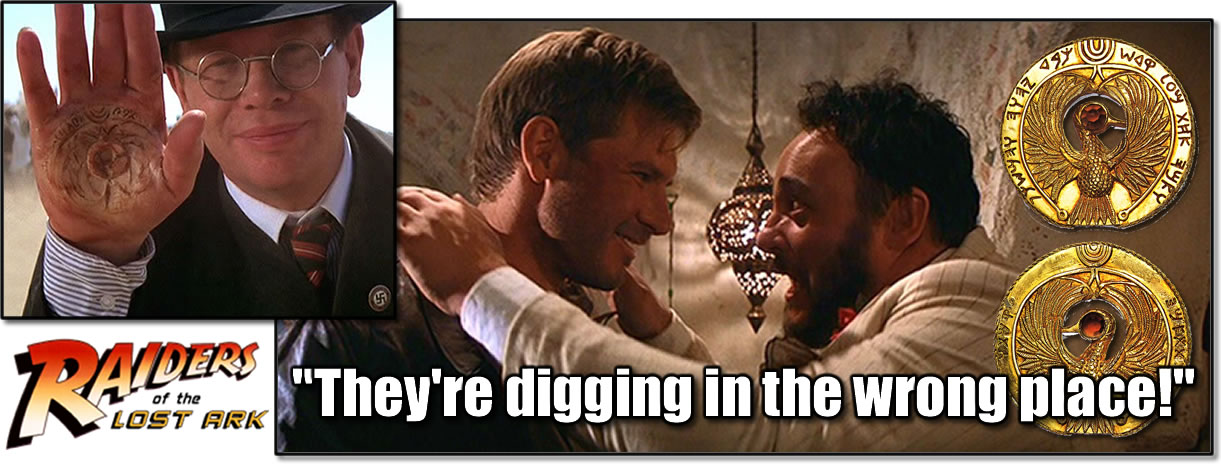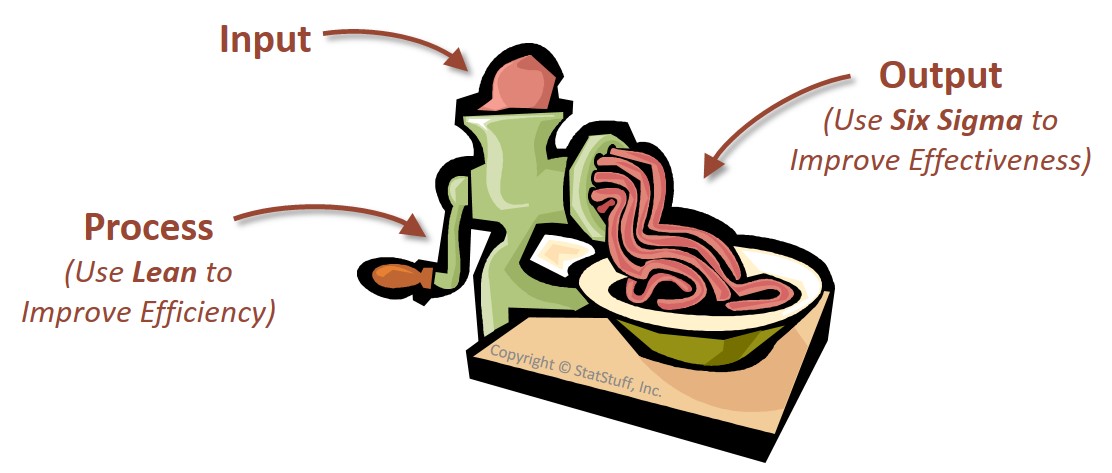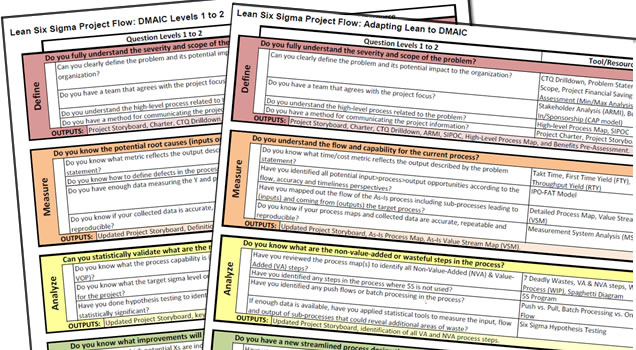
"They're digging in the wrong place!"
Spoiler alert (for anyone visiting from another planet who never saw "Raiders of the Lost Ark"): The Nazi treasure hunters got a copy of one side of Indiana Jones' gold medallion that helps reveal the location of the ark of the covenant. A famous turning point in the 1981 movie is when Jones learns the inscription on the opposite side of the medallion must also be used to more precisely calculate the exact location of the ark - which means the Nazis were digging in the wrong place.
In a similar way, Lean and Six Sigma are like two sides to the same coin where both sides should be used in balance with each other to improve the chance of finding the "hidden treasure" in the business - OK, maybe not the ark of the covenant, but it could still lead to the discovery of very valuable benefits.
Lean improves efficiency and Six Sigma improves effectiveness
A common description many folks use is to say Lean reduces waste and Six Sigma reduces variation. While that is partially correct, it doesn't fully illustrate the two-sided-coin representation of both Lean and Six Sigma. I prefer to instead describe how Lean improves efficiency and Six Sigma improves effectiveness.

So what is efficiency vs. effectiveness? I like to illustrate this as part of the Input > Process > Output (IPO) flow using a simple example of a meat grinder. The meat is the INPUT that goes into the grinder, the crank is the PROCESS that transforms the input to create the OUTPUT, the ground beef. Using this example, Lean focuses primarily on the process to find ways to improve the cost, speed, or flow, i.e., to make the process more efficient. Six Sigma focuses primarily on the output from the process to ensure it meets acceptable standards for quality and accuracy, i.e., to make the process (and its output) more effective.
So is it wrong to say Lean reduces waste and Six Sigma reduces variation? Not necessarily. One way the process can be more efficient is to find and eliminate waste (i.e., steps or parts that are not adding value or benefit to the customer) - but eliminating waste isn't the only way to make the process more efficient. Likewise, one way the process can be more effective is to find and eliminate variation (i.e., steps or parts that cause too many errors or defects in the output) - but eliminating variation isn't the only way to make the process more effective. In the end, Lean and Six Sigma should be used in balance with each other in order to find improvements to the process that yield measurable benefits to what the company cares about most (e.g., financial performance, customer satisfaction, etc.). These are also referred to as what's "critical to quality" (CTQ). To learn more about how to find CTQs in a business, check out this free video on the corporate CTQ drilldown.
Focus on Effectiveness first, then Efficiency
There's a lot of debate among LSS experts about whether Lean or Six Sigma should be applied first. The most common argument is to apply Lean first because the improvement opportunities tend to be easier to find and implement. However, the benefits tend to be much smaller and are rarely measured in balance with the effectiveness of the process or output. Personally, I don't prefer one method over another, but I do recommend that effectiveness (not necessarily Six Sigma) be evaluated before efficiency. The reason is because if our process is producing an output that doesn't meet acceptable quality or accuracy standards, then what good is it to make a "broken" process more efficient?
That doesn't mean we have to do Six Sigma first, but we should at least ensure the process meets the quality and accuracy expectations. By doing so we gain two benefits: 1) if it's not meeting quality/accuracy standards, then that should definitely be the first focus before speeding up a broken process, and 2) if it is meeting quality/accuracy standards, then we should at least measure those levels of quality to ensure our Lean improvements on making the process more efficient don't inadvertently compromise the quality/accuracy.
As a general rule, here are some simple questions that could be asked to know how to approach this:
- Does the output meet quality/accuracy standards?
- NO? Then use Six Sigma to improve it
- YES? Then measure the output before leaning the process
- Does the process meet speed/cost/flow standards?
- NO? Then use Lean to improve it
- YES? Then move on to another process
To learn more about these differences, check out StatStuff's video about the introduction to Lean and Six Sigma.
What's the difference between "six sigma" and "Six Sigma"?
Believe it or not there is a difference. The term "six sigma" originated as a reference to the statistical measurement of having six standard deviations (a.k.a., "sigmas") between the average (a.k.a., statistical mean) and some key data point (e.g., the customer's specification limit). OK, that sounds really technical. To simplify, it refers to having very little variation in a process so that the output from that process is more precise and accurate at meeting the customer's expectations; technically, it's allowing for only 3.4 defects/failures out every 1,000,000 opportunities - that's pretty good! Despite this statistical origin, it doesn't necessarily mean attaining "six sigma" is the goal. It may be more acceptable to allow more defects/errors and variation because the cost to make it any more precise would be too high.
Over time, the pursuit of attaining "six sigma" evolved into a formal methodology for collecting and statistically analyzing data in order to find root causes and implement improvements that fix those root causes. This methodology, based on the scientific method of problem solving, was divided into five phases commonly referred to as its acronym: DMAIC (duh-MAY-ick).
- DEFINE - understanding the problem
- MEASURE - collecting reliable data about the problem
- ANALYZE - analyzing the data to find the root causes
- IMPROVE - implementing improvements that fix the root causes
- CONTROL - sustaining the new improvements
So despite its statistical origins, this methodology of DMAIC eventually transcended the statistical aspect of "six sigma" and is now collectively referenced in the title of "Six Sigma". To learn more about the DMAIC methodology, check out this free video that describes it using a simple illustration based on my daughter's medical condition.

Leading LSS projects using the DMAIC Roadmaps
We barely scratched the surface at introducing LSS. Both Lean and Six Sigma have many sets of tools that can be used to successfully lead LSS projects. It can often be very overwhelming and confusing for those new to LSS. As a result, I built a DMAIC roadmap that serves as a simple guideline that outlines what questions you should be asking while working a LSS project and what tools can help a long the way. This roadmap is available at three levels of depth to help you in an easy step-by-step path toward leading your LSS project to success.
A unique aspect of this roadmap is that it's also available for the Lean perspective of improving process efficiency. Most roadmaps only focus on improving process effectiveness using the Six Sigma tools; after all, that's where the DMAIC methodology originated. But since the DMAIC methodology is really just built on the scientific method for problem solving, it can be easily adapted to the Lean perspective - after all, improving process efficiency can also be a big problem worth solving.
To learn more, check out this free video about the DMAIC roadmap using the Six Sigma approach. Also check out this free video about the DMAIC roadmap being adapted to the Lean approach.
About StatStuff
StatStuff is the only FREE source for complete Lean Six Sigma training. It is highly endorsed as quality Lean Six Sigma training from leaders at top companies like Apple, eBay, Pepsico, Bank of America, Dell, Sprint, BP, etc. Many other training organizations offer similar LSS training content for $2,000 - $7,000 and their training lasts 40 to 200 hours long. StatStuff’s free online training content is less than 28 hours – plus StatStuff offers Beginner and Intermediate training paths that can be completed in far less time. Many companies, training organizations, and universities are using StatStuff for their training curriculum. And why shouldn't they? There’s no risk, it’s less time, less money, and what better way is there to teach Lean Six Sigma than to apply Lean Six Sigma to their own training plan?



